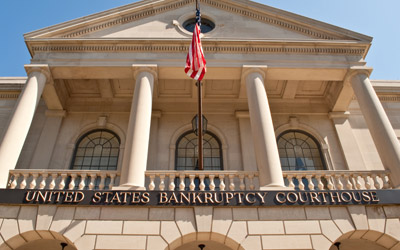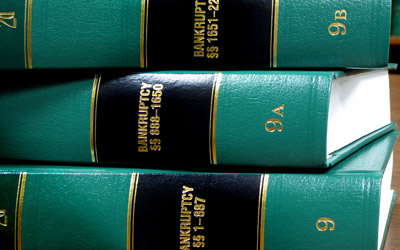Bankruptcy Articles
Glossary of Bankruptcy Terms
341 Meeting
A meeting of creditors at which the debtor is questioned under oath by creditors, a trustee, examiner, or the United States trustee about his/her financial affairs
Adversary Proceeding
A lawsuit arising in or related to a bankruptcy case that is commenced by filing a complaint with the bankruptcy court.
Assume
An agreement to continue performing duties under a contract or lease.
Automatic Stay
An injunction that automatically stops lawsuits, foreclosure, garnishments and all collection activity against the debtor the moment a bankruptcy petition is filed.
Bankruptcy
A legal procedure for dealing with debt problems of individuals and businesses; specifically, a case filed under one of the chapters of title 11 of the United States Code (the Bankruptcy Code).
Bankruptcy Code
The informal name for title 11 of the United States Code (11 U.S.C. § 101‑1330), the federal bankruptcy law.
Bankruptcy Court
The bankruptcy judges in regular active service in each district, a unit of the district court.
Bankruptcy Estate
All legal or equitable interests of the debtor in property, both real and personal, at the time of the bankruptcy filing. (The estate includes all property in which the debtor has an interest, even if it is owned or held by another person.)
Bankruptcy Judge
A judicial officer of the United States Bankruptcy Court who is the court official with decision‑making power over federal bankruptcy cases.
Bankruptcy Petition
A formal request for the protection of the federal bankruptcy laws. (There is an official form for bankruptcy petitions.)
Bankruptcy Trustee
A private individual or corporation appointed in all chapter 7, chapter 12, and chapter 13 cases to represent the interests of the bankruptcy estate and the debtor’s creditors.
Business Bankruptcy
A bankruptcy in which the debtor is a business or an individual involved in business and the debts were incurred primarily for business purposes.
Chapter 7
The chapter of the Bankruptcy Code providing for “liquidation,” i.e., the sale of a debtor’s nonexempt property and the distribution of the proceeds to creditors.
Chapter 7 Trustee
A person appointed in a chapter 7 case to represent the interests of the bankruptcy estate and the unsecured creditors. (The trustee’s responsibilities include reviewing the debtor’s petition and schedules, liquidating the property of the estate, and making distributions to creditors. The trustee may also bring actions against creditors or the debtor to recover property of the bankruptcy estate.) The Trustee works under the general supervision of the court and the direct supervision of the United States Trustee.
Chapter 13
The chapter of the Bankruptcy Code providing for adjustments of debts of an individual with regular income. (Chapter 13 allows a debtor to keep property and pay debts over time, usually three to five years.)
Chapter 13 Trustee
A person appointed to administer a chapter 13 case. (A chapter 13 trustee’s responsibilities are similar to those of a chapter 7 trustee; however, a chapter 13 trustee has the additional responsibilities of overseeing the debtor’s plan, receiving payments from debtors, and disbursing plan payments to creditors.) The Trustee works under the general supervision of the court and the direct supervision of the United States Trustee.
Claim
A creditor’s assertion of a right to payment from a debtor or the debtor’s property.
Complaint
The first or introductory document in a lawsuit that notifies the court and the defendant of the grounds claimed by the plaintiff for an award of money or other relief against the defendant.
Confirmation
Approval of a plan of reorganization by a bankruptcy judge. (Can be either a Chapter 11 or Chapter 13 Plan)
Consumer Bankruptcy
A bankruptcy case filed by a debtor who has primarily consumer debts.
Consumer Debt
Debts incurred for personal, as opposed to business, needs.
Contingent Claim
A claim that may be owed by the debtor under certain circumstances, for example, where a debtor is a cosigner on another person’s loan and that person fails to pay.
Creditor
A person or business to which the debtor owes money or that claims to be owed money by the debtor.
Credit Counseling
“Individual or group briefing” from a nonprofit budge and credit counseling agency that individual debtors must attend prior to filing under any chapter under the Bankruptcy Code.
Current Monthly Income
The average monthly income received by the debtor over six calendar months before the filing of the bankruptcy case, including regular contributions to household expenses from non-debtors and income from the debtor’s spouse if the petition is a joint petition, but not including social security income and other payments made because the debtor is victim of certain crimes.
Debtor
A person who has filed a petition for relief under the bankruptcy laws.
Debtor Education
The “instructional course in personal financial management” in chapters 7 and 13 that an individual debtor must complete before a discharge is entered.
Defendant
An individual (or business) against whom a lawsuit is filed.
Discharge
A release of a debtor from personal liability for certain dischargeable debts. (A discharge releases a debtor from personal liability for certain debts known as dischargeable debts and prevents the creditors owed those debts from taking any action against the debtor or the debtor’s property to collect the debts. The discharge also prohibits creditors from communicating with the debtor regarding the debt, including telephone calls, letters, and personal contact.)
Dischargeable Debt
A debt for which the Bankruptcy Code allows the debtor’s personal liability to be eliminated.
Disclosure Statement
A written document prepared by the chapter 11 debtor or other plan proponent that is designed to provide “adequate information” to creditors to enable them to evaluate the chapter 11 plan.
Equity
The value of a debtor’s interest in property that remains after liens and other creditors’ interests are considered. (Example: If a house valued at $60,000 is subject to a $40,000 mortgage, there is $20,000 of equity.)
Executory Contract or Lease
Generally includes contracts or leases under which both parties to the agreement have duties remaining to be performed. (If a contract or lease is executory, a debtor may assume it or reject it.)
Exempt
A description of any property that a debtor may prevent creditors from recovering.
Exempt Property
Property or value in property that a debtor is allowed to retain, free from the claims of creditors who do not have liens.
Exemption
Property that the Bankruptcy Code or applicable state law permits a debtor to keep from creditors.
Family Farmer or Family Fisherman
An individual, individual and spouse, corporation or partnership engaged in farming or fishing operation that meets certain debt limits and other statutory criteria for filing a petition under chapter 12.
Fraudulent Transfer
A transfer of a debtor’s property made with intent to defraud or for which the debtor receives less than the transferred property’s value.
Fresh Start
The characterization of a debtor’s status after bankruptcy, i.e, free of most debts. (Giving debtors a fresh start is one purpose of the Bankruptcy Code.)
Insider (of corporate debtor)
A director, officer, or person in control of the debtor; a partnership in which the debtor is a general partner; a general partner of the debtor; or a relative of a general partner, director, officer or person in control of the debtor.
Insider (of individual debtor)
Any relative of the debtor or of a general partner of the debtor; partnership in which the debtor is a general partner; general partner of the debtor; or corporation of which the debtor is a director, officer or person in control.
Joint Administration
A court‑approved mechanism under which two or more cases can be administered together. (Assuming no conflicts of interest, these seperate firms or individuals can pool their resources, hire the same professionals, etc.)
Joint Petition
One bankruptcy petition filed by a husband and wife together.
Lien
A charge upon specific property designed to secure payment of a debt or performance of an obligation.
Liquidated Claim
A creditor’s claim for a fixed amount of money.
Liquidation
A sale of a debtor’s property with the proceeds to be used for the benefit of creditors.
Means Test
Calculation to determine whether an individual debtor’s chapter 7 filing is presumed to be an abuse of the Bankruptcy Code requiring dismissal or conversion of the case.
Abuse is presumed if the debtor’s aggregate current monthly income over 5 years is above the state median income for a family of a specific size.
Motion To Lift Automatic Stay
A request by a creditor to allow the creditor to take an action against a debtor or the debtor’s property that would otherwise be prohibited by the automatic stay.
No‑Asset Case
A chapter 7 case where no assets are available to satisfy any portion of the creditors’ unsecured claims.
Non-dischargeable Debt
A debt that cannot be eliminated in bankruptcy.
Objection to Discharge
A trustee’s or creditor’s objection to the debtor’s being released from personal liability from certain discharged debts.
Objection to Exemptions
A trustee’s or creditor’s objection to a debtor’s attempt to claim certain property as exempt, i.e., not liable for any pre-petition debt of the debtor.
Party In Interest
A party who is actually and substantially interested in the subject matter, as distinguished from one who has only a nominal or technical interest in it.
Plaintiff
A person or business that files a formal complaint with the court.
Plan
A debtor’s detailed description of how the debtor proposes to pay creditors’ claims over a fixed period of time.
Post-petition Transfer
A transfer of a debtor’s property made after the commencement of the case.
Preferential Debt Payment
A debt payment made to a creditor in the 90‑day period before a debtor files bankruptcy (or within one year if the creditor was an insider) that gives the creditor more than the creditor would receive in the debtor’s chapter 7 case.
Priority
The Bankruptcy Code’s statutory ranking of unsecured claims that determines the order in which unsecured claims will be paid if there is not enough money to pay all unsecured claims in full.
Priority Claim
An unsecured claim that is entitled to be paid ahead of other unsecured claims that are not entitled to priority status.
Proof of Claim
A written statement describing the reason a debtor owes a creditor money. (There is an official form for this purpose).
Property Of The Estate
All legal or equitable Interests of the debtor in property as of the commencement of the case.
Reaffirmation Agreement
An agreement by a chapter 7 debtor to continue paying a dischargeable debt after the bankruptcy, usually for the purpose of keeping collateral or mortgaged property that would otherwise be subject to repossession.
Schedules
List submitted by the debtor along with the petition (or shortly thereafter) showing the debtor’s assets, liabilities, and other financial information. (There are official forms a debtor must use.)
Secured Creditor
An individual or business holding a claim against the debtor that is secured by a lien on property of the estate or that is subject to a right of set off.
Secured Debt
Debt backed by a mortgage, pledge of collateral, or other lien; debt for which the creditor has the right to pursue specific pledged property upon default.
Small Business Case
A special type of chapter 11 case in which there is no creditors’ committee and in which the debtor is subject to more oversight by the U.S. Trustee than other chapter 11 debtors.
Statement of Financial Affairs
A series of questions the debtor must answer in writing concerning sources of income, transfers of property, lawsuits by creditors, etc. (There is an official form a debtor must use.)
Statement of Intention
A declaration made by a chapter 7 debtor concerning plans for dealing with consumer debts that are secured by property of the estate.
Substantial Abuse
The characterization of a bankruptcy case filed by an individual whose debts are primarily consumer debts where the court finds that the granting of relief would be an abuse of chapter 7 because, for example, the debtor can pay its debts.
Substantive Consolidation
Putting the assets and liabilities of two or more related debtors into a single pool to pay creditors. (Courts are reluctant to allow substantive consolidation since the action must not only justify the benefit that one set of creditors receives, but also the harm that other creditors suffer as a result.)
Transfer
Any mode or means by which a debtor disposes of or parts with his/her property.
Petition Preparer
A business or individual not authorized to practice law that prepares bankruptcy petitions.
Under Secured Claim
A debt secured by property that is worth less than the amount of the debt.
United States Trustee
An officer of the Justice Department responsible for supervising the administration of bankruptcy cases, estates, and trustees, monitoring plans and disclosure statements, monitoring creditors’ committees, monitoring fee application, and performing other statutory duties.
Un-liquidated Claim
A claim for which a specific value has not been determined.
Unscheduled Debt
A debt that should have been listed by a debtor in the schedules filed with the court but was not.
Unsecured Claim
A claim or debt for which a creditor holds no special assurance or payment, such as a mortgage or lien; a debt for which credit was extended based solely upon the creditor’s assessment of the debtor’s future ability to pay.






